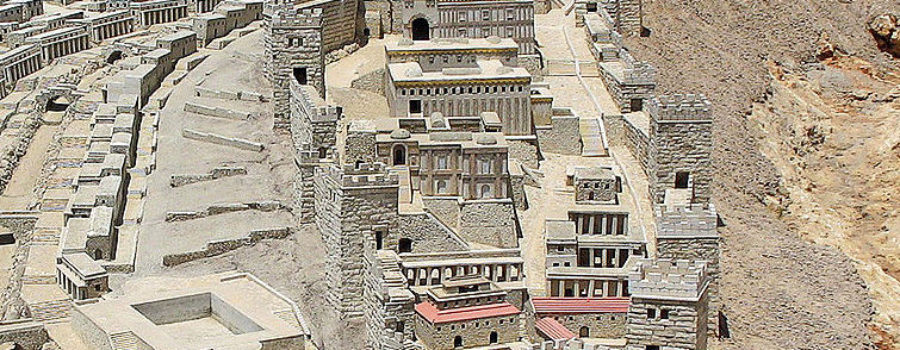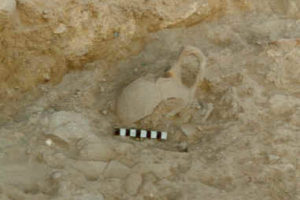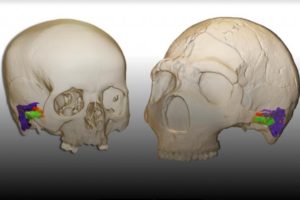For about 75 years following its return from the Philistines, the Ark of the Covenant remained in the House of Abinadab at Kirjath-jearim. It was there during most of Samuel’s leadership and during Saul’s 40-year reign. In a unity move, to make the city of David (Ir-David) both the religious as well as the political capital of the United Monarchy, David assembled 30,000 choice troops from all the tribes and went to bring the Ark to the city of David (2 Samuel 6:2).
Due to the incident of Uzzah, David decided not to remove the ark into the city of David, but rather lodged it outside the city into the house of Obed-edom the Gittite. There it remained three months (2 Samuel 6:10-11). Upon learning of the blessings which began flowing to Obed-edom, the king overcame his fear and decided he had better bring the Ark unto Jerusalem (formerly Jebus but now the city of David). David and his men, representing all of Israel, went and brought up the Ark of God from the house of Obed-edom into the city of David (2 Samuel 6:12, 16).
Josephus says that David,
transferred the ark to his own house; the priests carrying it, while seven companies of singers, who were set in that order by the king, went before it, and while he himself played upon the harp and joined in the music (Josephus, Antiquities 7.4.2§§84-85); (Whiston, 1987, p. 187).
Interestingly, it is with king David that public worship in the form of songs of praise, gratitude, and petition, first appears in the Hebrew Scriptures.
A talented musician and composer himself, David appointed Asaph, a brilliant musician, to oversee his royal singers and to begin public praise and worship in the royal capital (1 Chronicles 16:1). Asaph, a Levite, became the king’s choirmaster and composed twelve psalms.
The king, a great lover of music, recognized its power in worship and public events. Through choral music, sung to the accompaniment of a variety of instruments with responsive praise from the people, his royal choir celebrated the LORD’s presence in the city of David through public worship.
The Hebrew Scriptures cite three individuals, in particular, as organizers and leaders of various aspects of the musical liturgy: Heman, Asaph, and Ethan (commissioned in 1 Chronicles 15:17-22), who came from the Levitical clans of Kohath, Gershon, and Merari, respectively. They wrote Psalms, composed music for them, led the singing of them, and accompanied them with a variety of musical instruments including cymbals, harps, lyres, flutes, strings, timbrel (tambourine), and trumpets (1 Chronicles 15:16-25; Psalm 150).
This was not only the introduction of liturgy into the worship of God by Israel, but probably the beginning of formal corporate worship on the weekly Sabbath and the High Sabbaths. As this musical liturgy evolved the form moved into the Solomonic Temple and later into the synagogues. The chronicler in 2 Chronicles 8:12-16 records that Solomon established the liturgical traditions of the Temple according to the plan devised by his father David in accordance with the commandment of Moses.
The Psalms became the first prayer book of Israel. Of the 150 psalms attribution of authorship of the Psalms based on the Hebrew Scriptures is 75 to David, 1 to Moses (Psalm 90), 2 to Solomon (Psalms 72, 127), 12 to Asaph (Psalm 50, 73-83), 1 to Heman (Psalm 88), and 1 to Ethan (Psalm 89), 10 to the sons of Korah, and 48 are anonymous.
In a savvy political move, the king brought the Ark into the city of David in the midst of an enormous celebration. There was shouting and the sound of the shofar (1 Kings 6:15). As the Ark came into the city of David, Michal the daughter of Saul looked out the window, and saw king David leaping and dancing (1 Kings 6:16). The king’s men brought the Ark into the city of David and set it in its place in the midst of a tent which David had pitched for it.
The venue of the Ark was apparently an open area conducive to public worship, yet close to the king’s residence, within the fortress or Acra. In reference to this tent, David later described the Ark as resting “within curtains” (1 Kings 7:2). The sense of the matter is that in the Davidic court public worship through song and music arose as Sabbath rituals as there were no ritual sacrifices permitted except at the tent of meeting at Gibeon.
David then, once the ark came into the city of David and was set it in its place inside the tent, offered a burnt offering, a peace offering, and blessed the people in the name of the Lord of hosts (2 Samuel 6:17-18). He gave to all in attendance a cake of bread, a cake made in a pan, and a sweet cake. When his all guests had departed he turned to bless his own household (2 Samuel 6:19-20).
With the Ark of the Covenant lie safely lodged in the city of David in the curtained tent the official tent of meeting remained at Gibeon (1 Chronicles 16:39; 1 Kings 3:4). There were two high priests at this time, Zadok and Abiathar, who were both descendants of Aaron but from two different lines. They were cousins. Zadok was in charge of the tabernacle in Gibeon where for decades priests offered sin offerings. David placed Abiathar in charge of the ark in the city of David. Thus United Monarchy had two tabernacles at the same time, one in Jerusalem and one in Gibeon.
The Law of Moses provided for a national altar where the people of Israel were to offer their burnt offerings through the Aaronic priests but did not preclude construction of other altars serving as memorials or in unusual circumstances for burnt offerings on divine command. These other places of sacrifice were exceptions and not the general rule. While large amounts of fresh water were necessary for operation of the sacrificial system at the central sanctuary this appears not to be the case in the context of the other allowable altars. The tent containing the ark at the city of David did not replace the tent at Gibeon. There is no evidence that King David established a functioning priesthood replete with animal sacrifices at Jerusalem. His possession of the ark in Ir-David was a political move by a cunning desert chieftain.




Recent Comments